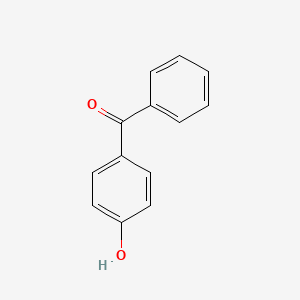D0738 | 4-hydroxybenzophenone
| Toxicity | Dose | Time | Species | Model | Method | Action | Positive criterion | Reference |
|---|---|---|---|---|---|---|---|---|
| MEMBRANE POTENTIAL | 41.31±18.12 | human | qHTS-HepG2 | MMP assay | decrease | IC50 | 163 | |
| MEMBRANE POTENTIAL | 28.18 | human | HepG2 | MMP assay | decrease | IC50 | 163 | |
| MEMBRANE POTENTIAL | 17.79±28.01 | rat | hepatocytes | MMP assay | decrease | IC50 | 163 | |
| Pictogram | Signal | Statements | Precautionary Statement Codes |
|---|---|---|---|
  |
Warning |
Aggregated GHS information provided by 77 companies from 9 notifications to the ECHA C&L Inventory. Each notification may be associated with multiple companies. Reported as not meeting GHS hazard criteria by 1 of 77 companies. For more detailed information, please visit ECHA C&L website Of the 8 notification(s) provided by 76 of 77 companies with hazard statement code(s): H315 (68.42%): Causes skin irritation [Warning Skin corrosion/irritation] H319 (68.42%): Causes serious eye irritation [Warning Serious eye damage/eye irritation] H335 (67.11%): May cause respiratory irritation [Warning Specific target organ toxicity, single exposure Respiratory tract irritation] H373 (26.32%): Causes damage to organs through prolonged or repeated exposure [Warning Specific target organ toxicity, repeated exposure] H412 (26.32%): Harmful to aquatic life with long lasting effects [Hazardous to the aquatic environment, long-term hazard] Information may vary between notifications depending on impurities, additives, and other factors. The percentage value in parenthesis indicates the notified classification ratio from companies that provide hazard codes. Only hazard codes with percentage values above 10% are shown. |
P260, P261, P264, P271, P273, P280, P302+P352, P304+P340, P305+P351+P338, P312, P314, P321, P332+P313, P337+P313, P362, P403+P233, P405, and P501; (The corresponding statement to each P-code can be found at the GHS Classification page.) |
| (4-HYDROXY-PHENYL)-PHENYLMETHANONE | (4-Hydroxy-phenyl)-phenyl-methanone | (4-Hydroxyphenyl)(phenyl)methanone |
| (4-Hydroxyphenyl)(phenyl)methanone # | (4-Hydroxyphenyl)phenylmethanone | (4-hydroxyphenyl)-phenyl-methanone |
| (4-hydroxyphenyl)-phenylmethanone | 04R2LWS0MS | 1-(4-Hydroxyphenyl)-1-phenylmethanone |
| 1137-42-4 | 4'-Hydroxybenzophenone | 4-Benzoylphenol |
| 4-HYDROXY-BENZOPHENONE | 4-Hydroxy benzophenone | 4-Hydroxybenzophenone |
| 4-Hydroxybenzophenone, 98% | 4-Hydroxybenzophenone, 98+% | 4-hydroxy-benzphenone |
| 4-hydroxylbenzophenone | 4-hydroxyphenyl phenyl ketone | AB00376867-03 |
| ACMC-1CA5I | AI3-00862 | AK-94847 |
| AKOS000119744 | ANW-16656 | BDBM50410491 |
| BIDD:ER0013 | Benzophenone, 4-hydroxy- | Benzophenone, 4-hydroxy- (6CI,7CI,8CI) |
| C14230 | CAS-1137-42-4 | CHEBI:34421 |
| CHEMBL194487 | CS-W015653 | CTK0H6390 |
| DB-041182 | DSSTox_CID_16684 | DSSTox_GSID_36684 |
| DSSTox_RID_79290 | DTXSID5036684 | EINECS 214-507-1 |
| F0001-0279 | FT-0618700 | InChI=1/C13H10O2/c14-12-8-6-11(7-9-12)13(15)10-4-2-1-3-5-10/h1-9,14; |
| KS-00000K9G | KSC176G9B | LS-91284 |
| LS10614 | MCULE-6455123564 | MFCD00002355 |
| Methanone, (4-hydroxyphenyl)phenyl- | N-(4-Hydroxylphenyl)-N'-phenylurea | NCGC00248965-01 |
| NCGC00248965-02 | NCGC00258781-01 | NE10180 |
| NPFYZDNDJHZQKY-UHFFFAOYSA-N | NSC 1887 | NSC-1887 |
| NSC1887 | P-HYDROXYBENZOPHENONE | PS-8242 |
| PubChem3313 | Q27116055 | RTR-002626 |
| SBB063296 | SC-00428 | SCHEMBL124916 |
| ST2414348 | ST50825425 | STK045122 |
| TR-002626 | TRA0077212 | Tox21_201229 |
| UNII-04R2LWS0MS | W-108613 | Z208331616 |
| ZINC388760 | p-Benzoylphenol |

